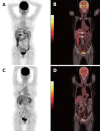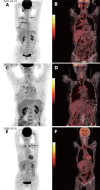Clinical usefulness of 18F-FDG PET/CT in the restaging of esophageal cancer after surgical resection and radiotherapy
- PMID: 19370780
- PMCID: PMC2670410
- DOI: 10.3748/wjg.15.1836
Clinical usefulness of 18F-FDG PET/CT in the restaging of esophageal cancer after surgical resection and radiotherapy
Abstract
Aim: To evaluate the clinical usefulness of (18)F-fluorodeoxyglucose positron emission and computed tomography ((18)F-FDG PET/CT) in restaging of esophageal cancer after surgical resection and radiotherapy.
Methods: Between January 2007 and Aug 2008, twenty histopathologically diagnosed esophageal cancer patients underwent 25 PET/CT scans (three patients had two scans and one patient had three scans) for restaging after surgical resection and radiotherapy. The standard reference for tumor recurrence was histopathologic confirmation or clinical follow-up for at least ten months after (18)F-FDG PET/CT examinations.
Results: Tumor recurrence was confirmed histopathologically in seven of the 20 patients (35%) and by clinical and radiological follow-up in 13 (65%). (18)F-FDG PET/CT was positive in 14 patients (68.4%) and negative in six (31.6%). (18)F-FDG PET/CT was true positive in 11 patients, false positive in three and true negative in six. Overall, the accuracy of (18)F-FDG PET/CT was 85%, negative predictive value (NPV) was 100%, and positive predictive value (PPV) was 78.6%. The three false positive PET/CT findings comprised chronic inflammation of mediastinal lymph nodes (n = 2) and anastomosis inflammation (n = 1). PET/CT demonstrated distant metastasis in 10 patients. (18)F-FDG PET/CT imaging-guided salvage treatment in nine patients was performed. Treatment regimens were changed in 12 (60%) patients after introducing (18)F-FDG PET/CT into their conventional post-treatment follow-up program.
Conclusion: Whole body (18)F-FDG PET/CT is effective in detecting relapse of esophageal cancer after surgical resection and radiotherapy. It could also have important clinical impact on the management of esophageal cancer, influencing both clinical restaging and salvage treatment of patients.
Figures



Similar articles
-
Clinical role of 18F-fluorodeoxyglucose positron emission tomography/computed tomography in post-operative follow up of gastric cancer: initial results.World J Gastroenterol. 2008 Aug 7;14(29):4627-32. doi: 10.3748/wjg.14.4627. World J Gastroenterol. 2008. PMID: 18698676 Free PMC article.
-
Detection of distant interval metastases after neoadjuvant therapy for esophageal cancer with 18F-FDG PET(/CT): a systematic review and meta-analysis.Dis Esophagus. 2018 Dec 1;31(12). doi: 10.1093/dote/doy055. Dis Esophagus. 2018. PMID: 29917073
-
Comparison of the diagnostic value of 3-deoxy-3-18F-fluorothymidine and 18F-fluorodeoxyglucose positron emission tomography/computed tomography in the assessment of regional lymph node in thoracic esophageal squamous cell carcinoma: a pilot study.Dis Esophagus. 2012 Jul;25(5):416-26. doi: 10.1111/j.1442-2050.2011.01259.x. Epub 2011 Sep 23. Dis Esophagus. 2012. PMID: 21951837 Clinical Trial.
-
Clinical utility of F-18 FDG PET/CT in recurrent breast carcinoma.Nucl Med Commun. 2012 Jun;33(6):591-6. doi: 10.1097/MNM.0b013e3283516716. Nucl Med Commun. 2012. PMID: 22334135
-
Role of ¹⁸F 2-fluoro-2-deoxyglucose positron emission tomography in upper gastrointestinal malignancies.World J Gastroenterol. 2011 Dec 14;17(46):5059-74. doi: 10.3748/wjg.v17.i46.5059. World J Gastroenterol. 2011. PMID: 22171140 Free PMC article. Review.
Cited by
-
Multi-site abdominal tuberculosis mimics malignancy on 18F-FDG PET/CT: report of three cases.World J Gastroenterol. 2010 Sep 7;16(33):4237-42. doi: 10.3748/wjg.v16.i33.4237. World J Gastroenterol. 2010. PMID: 20806445 Free PMC article.
-
Role of F18-FDG PET/CT in the Staging and Restaging of Esophageal Cancer: A Comparison with CECT.Indian J Surg Oncol. 2011 Dec;2(4):343-50. doi: 10.1007/s13193-012-0128-4. Epub 2012 Feb 18. Indian J Surg Oncol. 2011. PMID: 23204793 Free PMC article.
-
Detection of vertebral insufficiency fractures on 18F-FDG PET/CT following radiation therapy for oesophageal cancer.Radiol Case Rep. 2025 Jun 27;20(9):4669-4673. doi: 10.1016/j.radcr.2025.06.022. eCollection 2025 Sep. Radiol Case Rep. 2025. PMID: 40677874 Free PMC article.
-
Multiple primary malignant tumors of upper gastrointestinal tract: a novel role of 18F-FDG PET/CT.World J Gastroenterol. 2010 Aug 21;16(31):3964-9. doi: 10.3748/wjg.v16.i31.3964. World J Gastroenterol. 2010. PMID: 20712059 Free PMC article.
References
-
- Jemal A, Siegel R, Ward E, Murray T, Xu J, Thun MJ. Cancer statistics, 2007. CA Cancer J Clin. 2007;57:43–66. - PubMed
-
- Enzinger PC, Mayer RJ. Esophageal cancer. N Engl J Med. 2003;349:2241–2252. - PubMed
-
- Westerterp M, van Westreenen HL, Reitsma JB, Hoekstra OS, Stoker J, Fockens P, Jager PL, Van Eck-Smit BL, Plukker JT, van Lanschot JJ, et al. Esophageal cancer: CT, endoscopic US, and FDG PET for assessment of response to neoadjuvant therapy--systematic review. Radiology. 2005;236:841–851. - PubMed
-
- Kim TJ, Lee KH, Kim YH, Sung SW, Jheon S, Cho SK, Lee KW. Postoperative imaging of esophageal cancer: what chest radiologists need to know. Radiographics. 2007;27:409–429. - PubMed
-
- Lee SJ, Lee KS, Yim YJ, Kim TS, Shim YM, Kim K. Recurrence of squamous cell carcinoma of the oesophagus after curative surgery: rates and patterns on imaging studies correlated with tumour location and pathological stage. Clin Radiol. 2005;60:547–554. - PubMed
MeSH terms
Substances
LinkOut - more resources
Full Text Sources
Medical

